Dave Pensado's Plug-In Secrets
Mar 17, 2004 12:00 PM, by Mike Levine
Electronic Musician
With all of the contemporary pop and R&B songs that he mixes, Dave Pensado has become a huge fan of plug-in effects. In the April 2004 EM cover story, “Mixing Strategies of the Pros,” Pensado talks about two of his preferred plug-ins, the McDSP Compressor Bank CB2, that he uses for emulating the Fairchild compressor, and the Eventide Harmonizer H910 from Eventide’s Clockworks Legacy Bundle. Here, in Pensado’s own words, are descriptions of some more of his favorite plug-ins (listed in alphabetical order). The screen shots accompanying them show actual settings he’s used on some of his most high-profile mixes.
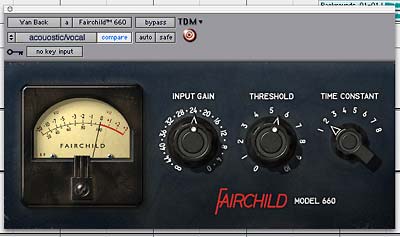
Bomb Factory Fairchild Model 660
“I rented maybe 7 or 8 Fairchilds, and on a blind test on a Christina Aguilera vocal, I liked this plug-in better. I didn’t know what was what. This plug-in is all over her latest album [Stripped RCA, 2002]. The screen shot shows the setting that I used.”

McDSP Chrome Tone
“It’s the first plug-in that allows you to take a chorus, a flanger, a wah, a delay, and a reverb and combine them into one effect. And it’s very efficient in its use of DSP. The distortion is great for vocals, guitars, and keyboards. It’s my new favorite effect. It’s so new that we haven’t had a chance to use on any records yet. I like it because it’s finally a plug-in that really gives you your money’s worth. It’s not just a half-assed chorus or a half assed distortion, it has world class versions of all of those things. I think that plug in sets the precedent for the future in terms of what you get for your money.”
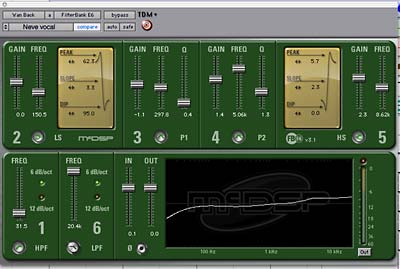
McDSP Filter Bank
“The McDSP E-Series Filter Bank plug-in is my favorite Neve EQ emulator. The setting shown here is a good Neve vocal sound. The problem that I have with a lot of old Neve EQs is that they’ve all been modified so much that you never know what you’re getting. You can quote me on this, who the hell can remember the differences between a 1081, a 1073, a 10 this, a 10 that? They all have their little quirks and idiosyncrasies. . . What I like more about the Filter Bank version than the original version is that I’m not limited to certain clicks or certain presets like the original has, but I can get in between the cracks. I’m not limited to just a 1073 or 83 but I can do shades and variations of the two. You can get some 21st-century brightness out of this plug-in that you can’t get out of the original. And then the low end, without phase shift is just real sweet.”
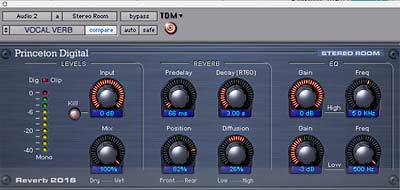
Princeton Digital 2016
“This is a great example that I really want people to understand. A lot of times a manufacturer will reissue the real version of an original piece of gear. Like there are new 1176’s out there. But the new [Eventide Reverb] 2016 is my favorite reissue ever. The SP2016 is my favorite reverb ever, and the reissue is just as good as the original. I’ve got the new one and I love it. Having said that, that plug-in that you see [Princeton Digital 2016], I love just as much as my original. That’s a vocal reverb that I used probably 50 percent of the time. If you listen to “Get the Party Started” by Pink, or “Family Portrait” by Pink [From the CD Missundaztood Arista, 2001] That’s the reverb I’m using on her vocal. That same exact setting is used a lot on just every record that I do, including on Brian McKnight’s new CD. Anyone familiar with my work, just go listen to a song, that’s the setting that I’m using. I’ll change the predelay to match the tempo of the song. I’ll change the decay. What I like to do is to listen to just the vocals and the drums by themselves and then tailor the timing elements of the plug-in to the timing of the drums.”
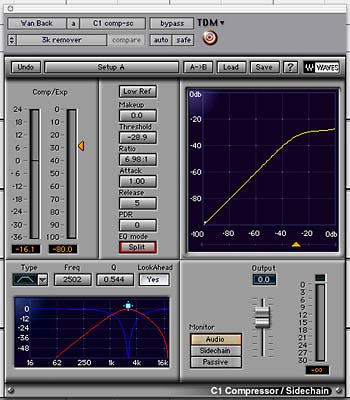
Waves C1 Compressor
“To me, of all the equalizers you could use on a vocal, I like this best. But you’re saying, ‘that’s not an equalizer, that’s a compressor.’ The way I set it up, it’s set up as a dynamic equalizer. In other words, what I’m doing is I’m telling the compressor to only compress the frequency that I’ve set it for. I’m telling the compressor that whenever the frequency gets above a certain threshold, knock it down. But you’re saying, ‘why can’t you do that with an equalizer’? Well you can, but it’s just not as smooth for some reason. If you listen to Christina Aguilera, she sings her verses smooth and powerful and round, and the compressor—if you could actually watch it—is actually doing nothing on those verses. But when she gets to the high notes, she gets a lot of 2 kHz in her vocal, and the compressor automatically pulls that down, and makes the vocals sound less harsh and less piercing. And you can control the amount you want to leave in. Christina actually likes a little bit of that in her vocal, so I can’t pull too much out, but the compressor does it automatically. This setting is useful on just about everything. If you move the frequency to 8 kHz, or 10 kHz, then you’ve automatically got a de-esser. The only thing you’ve got to be aware of is that it will automatically add about a 340-sample delay to your sound. So just highlight the waveform and shift it to the left, 340 samples, and you’ll be okay. Of all the plug-ins that I use, it’s the most utilitarian. The setting shown here is my setting. Of all the secrets I’m giving away, that could potentially be the most useful.”
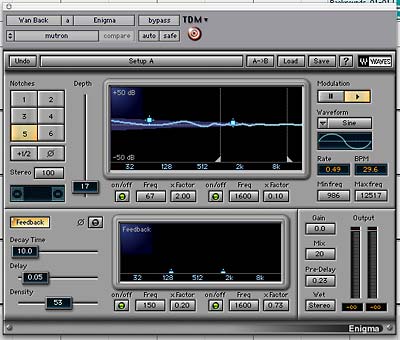
Waves Enigma
“This plug-in points out Waves’ philosophy to not just make plug-ins that emulate what’s in the real world, but to actually transcend what’s in the real world. What I like about Enigma is that you can go back and emulate a great piece of gear like a Mutron, but at the same time you can make it better with just a little bit of imagination. You’re not limited to what just what the Mutron can do. But you can make the listener feel he’s hearing the Mutron but even better. I’ve got a tiny bit of the Enigma [with the Mutron setting shown in this screen shot] on the piano on Christina Aguilera’s “Beautiful.” You’ve got to be careful with it. It can be a very useful subtle effect, or you can use it as a major component of the sound and get really radical too. It’s very versatile. It’s like a bi-phase chorus, but it’s much more than that. To call it a chorus is to limit your thinking as to what you can do with it. It’s one of the first of a new generation of effects that allow you to create things that don’t exist in the real world. It’s just a wonderful plug-in.”

Waves L1 Limiter
“The L1 is my favorite limiter. It’s got a lot of the attributes of an LA-2A, but none of the negatives. I really think that 40 years from now, the L1 will be looked at as a classic, just like the Fairchild compressor is looked at as a classic today. People fawning over software the way they do great analog compressors of today. The L1 I used on all of Christina Aguilera’s lead vocals on her last album. I use it last in the chain, and the setting that you see in this screen shot is straight off the song ‘Dirty,’ from Christina’s last album.”

Waves Renaissance Compressor
“It’s a real versatile, transparent compressor that wasn’t intentionally designed to emulate any one compressor but to emulate the best components of all the compressors. It’s release reminds me of an 1176. The knee and the attack and release curves can be made to sound like Fairchilds or LA-2As, LA-3As. It’s just a wonderful compressor; just a workhorse. Whatever you slap it on, it’s gonna sound great. And that particular setting [shown in the screen shot]—kind of like an LA-2A/Fairchild setting—is the one I like for background vocals. You can’t hear it, but it really makes the background vocals come to the front of the mix. That exact setting is from a Destiny’s Child song. It’s the one off the last album, Survivor.”

Waves Renaissance DeEsser
“It’s the best de-esser I use, period…This de-esser is fairly new from Waves, and you get more control than you ever had before. A lot of times the problem with deessers is they’ll give you a slight lisp on the vocals. That setting is off of Mya’s new album [Moodring Interscope, 2003]. I used it on ‘My Love is Like…Wo.’ It takes out the frequencies that you don’t want in a very unobtrusive way.”